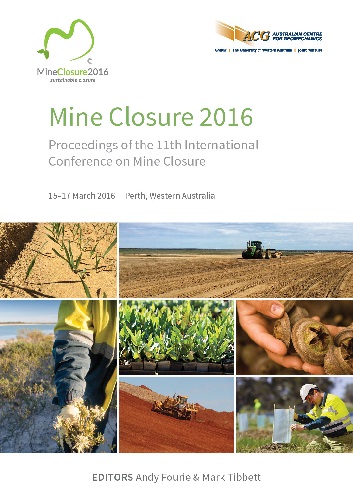The Challenger gold story — do it once, do it well

|
Authors: Waters, P; Bennett, K; Wingfield, B |
DOI https://doi.org/10.36487/ACG_rep/1608_45_Waters
Cite As:
Waters, P, Bennett, K & Wingfield, B 2016, 'The Challenger gold story — do it once, do it well', in AB Fourie & M Tibbett (eds), Mine Closure 2016: Proceedings of the 11th International Conference on Mine Closure, Australian Centre for Geomechanics, Perth, pp. 609-618, https://doi.org/10.36487/ACG_rep/1608_45_Waters
Abstract:
The Challenger gold mine (Challenger) is located in remote South Australia. Discovered in 1995, mining commenced in 2002. As a relatively new site with no mining legacies, Challenger provided an ideal site to plan the full lifecycle of mining based on digital mine planning, learnings from successful rehabilitation elsewhere, and the full awareness of industry legacy issues such as acid mine drainage, tailings storage and long term landform stability. This paper describes the key aspects that will impact the Challenger site post-mining, including: • Remote site. • Minimising the disturbance footprint. • Integrated management of tailings and waste rock. • Consideration of waste rock properties for landform construction. A key success factor for the Challenger site has been the progressive support of management towards sustainable mining. By adopting a life-of-mine approach, environmental considerations were incorporated at the inception of the project and have been actively managed during the life of the mine to the satisfaction of internal and external stakeholders. As a result, the operation has a very clear and concise plan as the operation matures and eventually moves towards closure. Adopting a fit-for-purpose, consistent approach to sustainable mining has resulted in cost-efficient environmental activities and confidence around the cost for mine closure.
References:
MWH 2014, Challenger Gold Mine, Ecosystem Function Analysis of Rehabilitated Integrated Waste Landforms (IWL) and Tailings Storage Facility 2, internal report for Kingsgate Consolidated Ltd.
MWH 2015, Challenger Gold Mine, Ecosystem Function Analysis of Rehabilitated Integrated Waste Landforms (IWL) and Tailings Storage Facility 2, internal report for Kingsgate Consolidated Ltd.
Tongway, D, Hindley, N, Ludwig, J, Kearns, A & Barnett, G 1997, ‘Early indicators of ecosystem rehabilitation on selected minesites’, 22nd Annual Mineral Council of Australia Environmental Workshop, pp. 494–505.
© Copyright 2024, Australian Centre for Geomechanics (ACG), The University of Western Australia. All rights reserved.
View copyright/legal information
Please direct any queries or error reports to repository-acg@uwa.edu.au
View copyright/legal information
Please direct any queries or error reports to repository-acg@uwa.edu.au